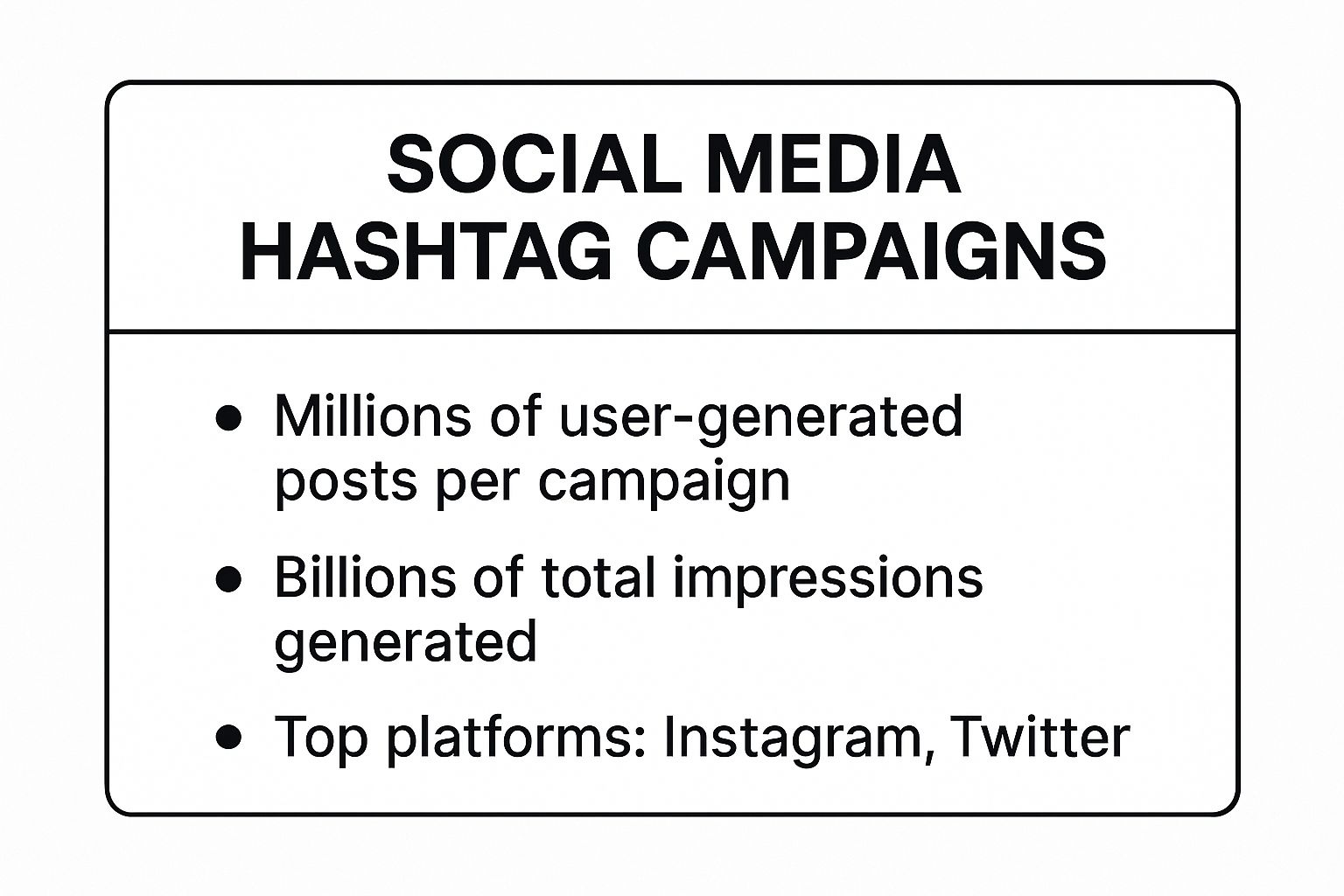In today's marketing landscape, authenticity isn't just a buzzword; it's the currency of trust. The most resonant brand stories aren't created in boardrooms; they're shared by real customers. User-generated content (UGC) has become the cornerstone of modern marketing, turning passive audiences into active brand advocates who build social proof and drive organic growth.
This article moves beyond generic success stories to deliver a strategic playbook. We will dissect powerful user generated content examples from leading brands, revealing the specific tactics and frameworks that fueled their success. You won't just see what worked; you'll understand why it worked and how to replicate it.
Each example includes a detailed breakdown of the strategy, key takeaways, and actionable steps you can apply to your own campaigns. Whether you aim to launch a viral hashtag campaign, leverage authentic customer reviews, or inspire compelling video testimonials, this guide provides the insights you need. Prepare to learn how to transform your customers into your most effective marketers and unlock a new level of authentic engagement. We will explore everything from social media challenges to in-depth community forums.
1. Social Media Hashtag Campaigns
Social media hashtag campaigns are a cornerstone of modern user-generated content (UGC) examples. This strategy involves creating a unique, branded hashtag and encouraging your audience to use it when sharing their own content, such as photos, videos, or stories related to your brand. It effectively turns customers into brand advocates, creating a stream of authentic content that builds community and social proof.
Campaigns like Coca-Cola's iconic #ShareACoke and Starbucks' annual #RedCupContest masterfully tap into consumer creativity. By providing a simple, engaging prompt, they invite participation on a massive scale. These initiatives succeed because they are not just about the product; they are about personal experiences and shared moments, making participation feel genuine rather than transactional. The result is a powerful, self-sustaining marketing engine fueled by the audience itself.
Strategic Analysis
The core strength of a hashtag campaign lies in its ability to centralize conversation and content. A well-crafted hashtag acts as a digital filing system, making it easy for brands to find, curate, and share high-quality UGC. This approach amplifies brand reach organically as each participant's post is exposed to their personal network.
Key Insight: Successful campaigns give users a reason to share that goes beyond just winning a prize. They tap into a desire for self-expression, community belonging, or creative recognition.
The infographic below highlights the immense scale and reach these campaigns can achieve.

This data underscores the incredible potential for organic amplification, with billions of impressions often stemming from just millions of user posts across top visual platforms like Instagram and TikTok.
Actionable Takeaways
To replicate this success, focus on creating a campaign that is both simple and compelling.
- Define a Clear Goal: What do you want to achieve? Increase brand awareness, gather product photos, or promote a new launch?
- Create a Memorable Hashtag: Keep it short, unique, and easy to spell. For a deeper dive, explore this ultimate hashtags guide on evergreenfeed.com.
- Offer a Compelling Incentive: This doesn’t have to be a big prize. Often, the chance to be featured on your brand's official page is motivation enough.
- Promote and Engage: Announce the campaign across all channels and actively engage with participants by liking, commenting on, and re-sharing their submissions.
2. Customer Review and Rating Systems
Customer review and rating systems are foundational user generated content examples, empowering consumers to share their direct experiences with products, services, or businesses. This model allows users to assign a star rating and leave detailed written feedback, creating a public record of their satisfaction. It’s an invaluable source of social proof that directly influences the purchasing decisions of prospective customers.
Platforms like Amazon, TripAdvisor, and Google My Business have normalized this behavior, making reviews a critical part of the customer journey. Consumers actively seek out the opinions of their peers to validate their choices. For businesses, this system provides a constant stream of authentic feedback, highlighting strengths and revealing areas for improvement. The result is a transparent ecosystem where quality is rewarded and customer voice directly impacts brand reputation.
Strategic Analysis
The primary power of customer reviews lies in their ability to build trust and credibility at scale. Unlike brand-generated marketing messages, reviews are perceived as unbiased and authentic, coming directly from real users. This peer-to-peer validation is often the final piece of information a consumer needs to convert.
Key Insight: Responding to reviews, both positive and negative, is as important as collecting them. Active engagement demonstrates that a brand is listening, values customer feedback, and is committed to service excellence, which can turn a negative experience into a display of great customer care.
By systematically collecting and showcasing this feedback, brands can significantly reduce purchase friction and build a loyal community around their offerings.
Actionable Takeaways
To effectively leverage customer reviews, brands must be proactive in both gathering and managing feedback.
- Actively Solicit Reviews: Use post-purchase email or SMS campaigns to encourage satisfied customers to share their experience. Make the process as simple as possible.
- Respond to All Feedback: Thank customers for positive reviews and address negative ones professionally and constructively. A public response shows you care.
- Showcase Reviews Prominently: Integrate a reviews widget on your product pages, homepage, and even in your marketing materials to maximize their impact.
- Analyze Feedback for Insights: Use reviews as a direct line to your customers. For a deeper look at managing your online reputation through reviews, explore this in-depth guide from BrightLocal.
3. Video Testimonials and Success Stories
Video testimonials are one of the most persuasive user generated content examples, featuring authentic stories from customers sharing their positive experiences with a product or service. This format transforms satisfied users into compelling storytellers, offering powerful social proof that resonates far more deeply than traditional advertising. It allows potential customers to see and hear real results from people they can relate to.
Brands like Peloton and HubSpot have built powerful marketing assets around member transformation stories and customer success videos. These videos are effective because they focus on the emotional journey and tangible outcomes, not just product features. By showcasing authentic, unscripted praise, companies build a powerful narrative of trust and reliability, directly addressing the skepticism of modern consumers.

Strategic Analysis
The primary strength of video testimonials lies in their ability to convey emotion and build trust. Unlike text reviews, video captures tone, expression, and sincerity, creating a much stronger connection with the viewer. This format excels at demonstrating complex or results-oriented products where seeing is believing, such as B2B software (Slack, Shopify) or fitness programs (Peloton).
Key Insight: The most impactful video testimonials are not overproduced. A slightly raw, authentic feel often performs better because it appears more genuine and less like a scripted advertisement.
To further build trust and authenticity, consider dedicated platforms for showcasing customer testimonials. These tools can help organize and present user-submitted videos in a structured, credible format on your website or landing pages, maximizing their impact.
Actionable Takeaways
To effectively source and leverage video testimonials, focus on making the process as simple as possible for your customers.
- Provide Clear Guidelines: Offer a simple brief with guiding questions or prompts. Ask customers to focus on the problem they had and the specific results they achieved.
- Offer a Meaningful Incentive: A small gift card, a discount on future purchases, or exclusive brand swag can be enough to encourage participation.
- Keep It Concise: Encourage customers to keep their videos between 30 and 90 seconds to maintain viewer engagement, especially for social media.
- Repurpose Across Channels: Share the best videos on your website's homepage, in email campaigns, on social media, and even in paid ad campaigns to maximize their reach and impact.
4. Photo and Video Contests
Photo and video contests are a classic and highly effective form of user generated content examples. This strategy incentivizes audiences to create and submit high-quality visual content based on a specific theme, product, or brand experience in exchange for a prize. It gamifies content creation, turning passive followers into active participants eager to showcase their creativity.
Brands like GoPro have built their entire marketing strategy around this concept with their GoPro Awards, while Doritos' legendary "Crash the Super Bowl" contest invited fans to create their own commercials. These initiatives work because they offer a clear value exchange: participants get a chance to win significant prizes and gain recognition, while the brand receives a vast library of authentic, compelling marketing assets.
Strategic Analysis
The primary power of a contest lies in its ability to generate high-quality, on-brand content at scale. Unlike passive hashtag campaigns, a contest’s competitive nature often motivates users to produce more polished and creative submissions. This provides the brand with a treasure trove of visuals that can be repurposed for social media, advertisements, and website content, often at a fraction of the cost of professional shoots.
Key Insight: The most successful contests align the prize with the brand's identity and the audience's desires. A travel company offering a trip, or a camera brand offering new gear, creates a more compelling and authentic incentive than a generic cash prize.
This approach not only populates a brand's content calendar but also fosters a deeper sense of community and brand loyalty. Participants become more invested in the brand's success, eagerly watching to see who wins and sharing the contest with their own networks.
Actionable Takeaways
To launch a successful photo or video contest, you need a well-defined structure and a compelling proposition.
- Set Clear and Simple Rules: Outline submission guidelines, deadlines, and judging criteria clearly. Complicated rules create a barrier to entry. For legal best practices, see this guide to contest rules from ShortStack.
- Offer an Attractive Prize: The prize should be valuable and relevant to your target audience. Experiences, exclusive products, or significant public recognition often perform better than cash.
- Secure Content Rights: Your terms and conditions must clearly state that you have the right to use submitted content for marketing purposes. This is a critical step to avoid legal issues.
- Promote and Showcase Entries: Promote the contest heavily across all channels. Regularly feature top entries during the submission period to maintain momentum and inspire others to participate.
5. Unboxing and Product Demo Videos
Unboxing and product demo videos are powerful user-generated content examples that capture the authentic excitement of a customer's first interaction with a product. This format involves users filming the entire experience, from opening the packaging to demonstrating the product's features. It offers potential buyers a genuine, unscripted look at what they can expect, building trust and anticipation in a way polished brand advertisements cannot.

The phenomenon was popularized by tech enthusiasts unboxing the latest Apple products and has since been adopted across countless industries. From beauty influencers revealing subscription box contents to gamers showcasing new hardware, these videos serve as relatable testimonials. They tap into the vicarious thrill of a new purchase, making them highly engaging and persuasive for viewers on the fence.
Strategic Analysis
The strategic value of unboxing videos lies in their ability to showcase product value and build social proof simultaneously. Viewers see the product through the eyes of a real person, which helps answer practical questions about packaging, quality, and initial setup. This peer-to-peer validation is often more influential than direct brand messaging, as it feels more objective and trustworthy.
Key Insight: The magic of unboxing content is its rawness. An unscripted, genuine reaction builds a layer of trust that scripted, professional advertisements struggle to achieve.
This type of user-generated content effectively outsources marketing to your most enthusiastic customers. It provides an unfiltered look at your product while organically reaching new audiences through the creator's personal network, making it a highly efficient form of word-of-mouth marketing.
Actionable Takeaways
To encourage customers to create and share unboxing videos, you need to create a memorable experience from the moment the package arrives.
- Elevate Your Packaging: Invest in branded, high-quality packaging that makes the unboxing feel like a special event.
- Encourage, Don’t Script: Provide a gentle prompt in your packaging or follow-up emails, but let customers share their honest, authentic reactions.
- Engage with Creators: Monitor platforms like YouTube for mentions of your brand. When you find a video, share it on your own channels and thank the creator. You can find more tips in this guide to marketing your business on YouTube from evergreenfeed.com.
- Send Products to Advocates: Identify loyal customers or micro-influencers and send them products as a gift, increasing the likelihood they will share their experience.
6. Community Forums and Q&A Platforms
Community forums and Q&A platforms are powerful user generated content examples where the audience builds a knowledge base by asking questions, sharing expertise, and providing solutions. These dedicated spaces, often hosted by a brand or centered around a specific interest, become invaluable, self-perpetuating resources that foster loyalty and reduce support overhead.
Platforms like the Salesforce Trailblazer Community or Adobe’s robust support forums exemplify this model. Instead of just selling products, these brands cultivate ecosystems where users help each other solve complex problems. The content generated is highly specific and practical, directly addressing real-world user challenges and creating a searchable library of solutions that benefits everyone.
Strategic Analysis
The primary strength of a community forum is its ability to build a scalable, user-driven support system. Every question answered by a community member is one less support ticket for the brand and a public resource for future users with the same issue. This creates a powerful network effect where the value of the community increases with each new contribution.
Key Insight: These platforms transform customers from passive consumers into active problem-solvers and product experts, creating a deep sense of ownership and brand investment.
This model is particularly effective for technical products, software, or specialized hobbies where peer-to-peer knowledge sharing is essential for user success and mastery.
Actionable Takeaways
To build a thriving community forum, focus on empowerment and structure.
- Seed the Community: Launch with foundational content, such as FAQs and tutorials, to provide initial value and guide the first conversations.
- Recognize Top Contributors: Implement gamification elements like badges, leaderboards, or special titles to reward and motivate your most active and helpful members.
- Establish Clear Guidelines: Create and enforce rules for conduct to ensure the space remains a respectful, constructive, and safe environment for all users.
- Engage Authentically: Have brand representatives participate by answering questions, clarifying information, and, most importantly, listening to feedback to improve products.
7. Social Media Challenges and Trends
Social media challenges and trends are powerful, often viral, user-generated content examples where people participate in a shared activity. These typically involve specific songs, dances, filters, or creative prompts that spread rapidly across platforms like TikTok and Instagram, inviting mass participation and personalization. Users adapt the format, adding their own unique spin while staying within the trend's framework.
The ALS Ice Bucket Challenge is a classic example of a trend driving massive awareness and real-world impact. More recently, brand-specific campaigns like e.l.f. Cosmetics' #eyeslipsface challenge on TikTok leveraged a catchy, original song to generate billions of views. These challenges succeed by providing a low-barrier, fun way for users to create content, connect with a larger movement, and express themselves.
Strategic Analysis
The primary strength of this UGC format is its inherent virality and cultural relevance. By tapping into an existing trend or creating a new one, brands can ride a wave of organic momentum that is nearly impossible to replicate with paid advertising. It allows a brand to become part of the cultural conversation in a way that feels authentic and user-driven rather than intrusive.
Key Insight: The most successful challenges are simple to understand, easy to replicate, and offer a high degree of creative freedom. They empower users to be the star, with the brand or cause acting as the stage.
This approach leverages the network effect, where each new participant not only creates content but also serves as a promoter, encouraging their followers to join in.
Actionable Takeaways
To leverage trends and challenges effectively, brands must be agile and creative.
- Monitor Trends Constantly: Use platform-native tools and social listening to identify emerging trends your brand can authentically participate in. Speed is critical.
- Create an Original Challenge: Develop a simple, brand-relevant challenge with a unique hashtag and perhaps an original audio clip. Make the call-to-action clear and easy.
- Make Participation Easy: The barrier to entry should be extremely low. Avoid complex rules or requirements that might discourage users from creating.
- Seed the Trend: Partner with a few relevant influencers to kickstart the challenge and provide high-quality examples for others to follow. Much like hosting a great online event, initial momentum is key, a concept explored in this guide to getting started with Twitter chats.
8. Customer Case Studies and Success Stories
Customer case studies and success stories are a powerful form of user-generated content that goes beyond a simple review. This strategy involves collaborating with satisfied clients to create detailed narratives showcasing how they used your product or service to solve a specific problem and achieve measurable results. It transforms a customer's positive experience into a compelling story that provides deep social proof and demonstrates your value proposition in a real-world context.

Companies like HubSpot and Salesforce are masters of this format, building extensive libraries of customer stories that address various industries and use cases. These are not just testimonials; they are in-depth explorations of challenges, solutions, and outcomes. By framing the customer as the hero of the story, brands can educate prospects and build trust in a highly authentic and relatable way. This approach is one of the most effective user generated content examples for B2B marketing.
Strategic Analysis
The core strength of a case study lies in its ability to translate product features into tangible business outcomes. While marketing copy can list benefits, a customer's story proves them. This narrative format helps potential buyers envision themselves achieving similar success, making the decision-making process much easier.
Key Insight: The most impactful case studies are not about your company being the hero. They are about your customer overcoming a challenge, with your product serving as the essential tool that enabled their victory.
This shift in focus from "what our product does" to "what our customer achieved" is critical for creating content that resonates deeply with prospects who are facing similar obstacles.
Actionable Takeaways
To create compelling case studies, focus on storytelling and concrete data.
- Identify the Right Candidates: Look for customers who have achieved specific, quantifiable results and are enthusiastic advocates for your brand.
- Structure a Clear Narrative: Follow a classic problem-solution-result framework. Clearly outline the customer's initial challenge, how your product was implemented, and the measurable impact it had. For guidance, explore HubSpot’s comprehensive customer stories library.
- Use Data and Quotes: Incorporate specific metrics (e.g., "30% increase in lead conversion") and direct quotes from the customer to add credibility and authenticity.
- Repurpose Across Channels: Create multiple formats from one story. A detailed written study can be turned into a video, an infographic, a blog post, and several social media snippets to maximize its reach.
User Generated Content Types Comparison
| Strategy | Implementation Complexity 🔄 | Resource Requirements ⚡ | Expected Outcomes 📊 | Ideal Use Cases 💡 | Key Advantages ⭐ |
|---|---|---|---|---|---|
| Social Media Hashtag Campaigns | Moderate – requires ongoing promotion & monitoring | Low to moderate – mostly social media management | High – potential for millions of posts, billions of impressions | Brand awareness, community building, viral marketing | Cost-effective, builds authentic community, increases visibility |
| Customer Review and Rating Systems | Moderate – needs review management & monitoring | Moderate – platform tools and response efforts | High – builds trust, influences purchase decisions | E-commerce, service feedback, consumer trust | Builds credibility, improves SEO, provides free market insights |
| Video Testimonials and Success Stories | High – time-intensive production & editing | High – video recording, editing resources | Very high – can increase conversion rates up to 34% | Conversion optimization, emotional branding | High trust, strong emotional impact, versatile content |
| Photo and Video Contests | High – requires rules, promotion, judging | High – prize incentives, legal management | High – generates large creative content volumes | Content creation, engagement boosts, brand excitement | Cost-effective content creation, community engagement |
| Unboxing and Product Demo Videos | Moderate – depends on influencer/customer participation | Moderate – product supply & monitoring content | Moderate to high – millions of views possible | Product launches, tech/beauty marketing | Authentic insights, builds excitement, detailed info |
| Community Forums and Q&A Platforms | High – requires active moderation and maintenance | High – staffing/moderation, platform management | High – comprehensive knowledge base, reduced support load | Customer support, knowledge sharing, SEO improvement | Engaged communities, valuable customer insights |
| Social Media Challenges and Trends | Moderate to high – creative development & quick execution | Low to moderate – social media and influencer engagement | Very high – viral reach, billions of views possible | Viral marketing, rapid brand awareness | Massive organic reach, high engagement, cost-effective |
| Customer Case Studies and Success Stories | High – detailed development, data collection | High – customer collaboration and content creation | High – influences 73% of B2B decisions | B2B marketing, detailed product validation | Detailed proof, builds credibility, data-driven storytelling |
Putting UGC to Work: Your Action Plan for Authentic Marketing
As we've explored through these diverse user generated content examples, a powerful, unifying theme emerges. The most successful brands don't just sell products; they build communities and empower their customers to become advocates. From the high-energy virality of a TikTok challenge to the quiet trust built by a detailed customer review, the common thread is authenticity. This isn't about manufacturing marketing messages; it's about creating a space for genuine stories and experiences to flourish.
The core lesson is that your audience trusts their peers far more than they trust a polished advertisement. By shifting the spotlight onto them, you transform your marketing from a monologue into a dynamic, engaging conversation. This strategy doesn't just generate content; it builds brand loyalty, fosters a sense of belonging, and creates a powerful, self-sustaining engine of social proof that resonates deeply with potential customers.
Your Strategic UGC Blueprint
Moving from inspiration to implementation is the critical next step. The examples above, from hashtag campaigns to detailed case studies, are not just interesting ideas but replicable strategies. The key is to choose the right approach for your brand, your audience, and your specific marketing goals. Here’s a simple, actionable plan to get started:
-
Start with a Content Audit: Before launching a new campaign, look for the UGC that already exists. Where are customers tagging you? What are they saying in reviews or community forums? This existing content is your low-hanging fruit and provides invaluable insight into what motivates your audience to share.
-
Choose Your Focus: You don't need to do everything at once. Select one or two UGC types that align perfectly with your brand's strengths. If you have a visually appealing product, a photo contest or an unboxing video campaign might be the perfect fit. If you offer a complex service, customer testimonials or in-depth case studies will build the necessary trust.
-
Create Clear Pathways for Submission: Make it incredibly easy for users to participate. This means clear guidelines, dedicated hashtags, simple submission forms, or prominent review sections on your website. Friction is the enemy of participation, so remove every possible barrier.
-
Promote, Amplify, and Reward: Your role is to be the amplifier. Feature the best user generated content examples prominently on your social media, website, and in your email newsletters. Publicly celebrate your contributors, offer incentives, and make them feel like valued partners in your brand's story.
By systematically encouraging, collecting, and showcasing your customers' voices, you build a marketing flywheel fueled by the most credible source possible: real people. This approach not only scales your content production but also deepens the connection between your brand and the community you serve. The result is a more resilient, trusted, and authentic brand identity that can thrive in any market.
Ready to put your best user-generated content on autopilot? EvergreenFeed makes it simple to collect your top-performing testimonials, reviews, and customer photos into content libraries and automatically share them across your social media channels. Stop letting your most powerful social proof get buried and start maximizing its impact by visiting EvergreenFeed to learn more.




